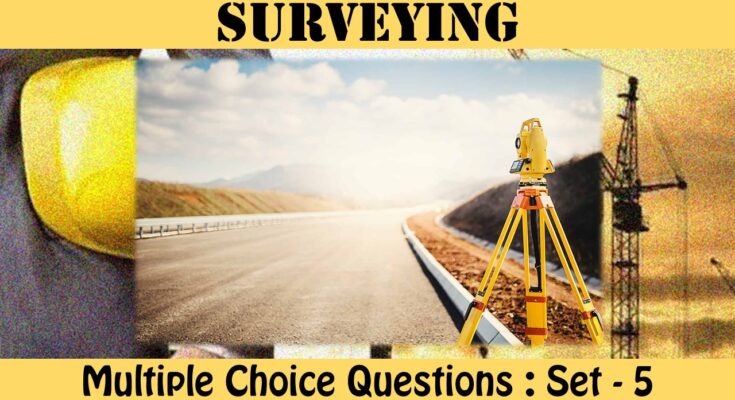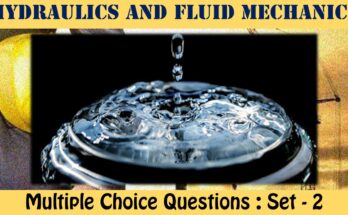MCQ Questions Civil Engineering Surveying
The interviewer is almost as nervous as the candidate in most interviews. You might wonder if you look confident enough, if you will hire the right person, or if you are asking the right engineering interview questions. The last question is arguably the most crucial part to worry about when you’re interviewing candidates. Other topics on Civil Engineering Multiple Choice Questions can be accessed
MCQ Questions Civil Engineering Surveying - Set - 5
Question 1:
In an internal focusing type of telescope, the lens provided is
a) concave
b) convex
c) plano-convex
d) plano-concave
Correct Answer – (A)
Question 2 :
The rise and fall method of levelling provides a complete check on
a) backsight
b) intermediate sight
c) foresight
d) all of the above
Correct Answer – (D)
Question 3 :
A ’level line’ is a
a) horizontal line
b) line parallel to the mean spheriodal surface of earth
c) line passing through the center of cross hairs and the center of eye piece
d) line passing through the objective lens and the eye-piece of a dumpy or tilting level
Correct Answer – (B)
Question 4 :
If a tripod settles in the interval that elapses between taking a back sight reading and the following foresight reading, then the elevation of turning point will
a) increase
b) decrease
c) not change
d) Both ‘a’ or ‘b’
Correct Answer – (A)
Question 5 :
Which of the following errors can be eliminated by taking mean of bot face observations ?
a) error due to imperfect graduations
b) error due to eccentricity of verniers
c) error due to imperfect adjustment of plate levels
d) error due to line of collimation not being perpendicular to horizontal axis
Correct Answer – (D)
MCQ Questions Civil Engineering Surveying
Question 6:
If the R.L. of a B.M. is 100.00 m, the back- sight is 1.215 m and the foresight is 1.870 m, the R.L. of the forward station is
a) 99.345 m
b) 100.345 m
c) 100.655m
d) 101.870m
Correct Answer – (A)
Question 7:
The following sights are taken on a “turning point”
a) foresight only
b) backsight only
c) foresight and backsight
d) foresight and intermediate sight
Correct Answer – (C)
Question 8:
If altitude bubble is provided both on index frame as well as on telescope of a theodolite, then the instrument is levelled with reference to
i) altitude bubble on index frame
ii) altitude bubble on index frame if it is to be used as a level
iii) altitude bubble on telescope
iv) altitude bubble on telescope if it is to be used as a level The correct answer is
a) only (i)
b) both (i) and (iv)
c) only (iii)
d) both (ii) and (iii)
Correct Answer – (B)
Question 9:
Which of the following errors cannot be eliminated by taking both face observations ?
a) error due to horizontal axis not being perpendicular to the vertical axis
b) index error i.e. error due to imperfect adjustment of the vertical circle vernier
c) error due to non-parallelism of the axis of telescope level and line of collimation
d) none of the above
Correct Answer – (D)
Question 10:
In the double application of principle of reversion, the apparent error is
a) equal to true error
b) half the true error
c) two times the true error
d) four times the true error
Correct Answer – (D)
- NCERT Solutions Class 12 Mathematics RD Sharma Sets : Exercise 1.1
- NCERT Solutions Class 12 Mathematics RD Sharma Sets : Exercise 1.2
- NCERT Solutions Class 12 Mathematics RD Sharma Sets : Exercise 1.3
- NCERT Solutions Class 12 Mathematics RD Sharma Sets : Exercise 1.4
- NCERT Solutions Class 12 Mathematics RD Sharma Trigonometric Functions : Exercise – 5.1
- NCERT Solutions Class 12 Mathematics RD Sharma Trigonometric Functions : Exercise – 5.2
- NCERT Solutions Class 12 Mathematics RD Sharma Trigonometric Functions : Exercise – 5.3
- NCERT Solutions Class 12 Mathematics RD Sharma Quadratic Equations : Exercise – 14.1
- NCERT Solutions Class 12 Mathematics RD Sharma Quadratic Equations : Exercise – 14.2
- NCERT Solutions Class 12 Mathematics RD Sharma Linear Inequations : Exercise – 15.1
- NCERT Solutions Class 12 Mathematics RD Sharma Linear Inequations : Exercise – 15.2
- NCERT Solutions Class 12 Mathematics RD Sharma Linear Inequations : Exercise – 15.3
- NCERT Solutions Class 12 Mathematics RD Sharma Linear Inequations : Exercise – 15.4
- NCERT Solutions Class 12 Mathematics RD Sharma Linear Inequations : Exercise – 15.5
- NCERT Solutions Class 12 Mathematics RD Sharma Linear Inequations : Exercise – 15.6
Multiple Choice Questions for Competitive Exams
- Multiple Choice Questions Class 12 Chemistry The Solid State
Set -1 Set -2 Set -3 Set -4 Set -5 - MCQ Questions Class 12 Solutions With Answers
Set -1 Set -2 Set -3 Set -4 Set -5 - MCQ Questions Class 12 Electrochemistry With Answers
Set -1 Set -2 Set -3 Set -4 Set -5 - MCQ Questions Class 12 Chemical Kinetics With Answers
Set -1 Set -2 Set -3 Set -4 Set -5 - MCQ Questions Class 12 Surface Chemistry With Answers
Set -1 Set -2 Set -3 Set -4 Set -5 - MCQ Questions Class 12 General Principles and Processes of Isolation of Elements With Answers
Set -1 Set -2 Set -3 Set -4 Set -5




